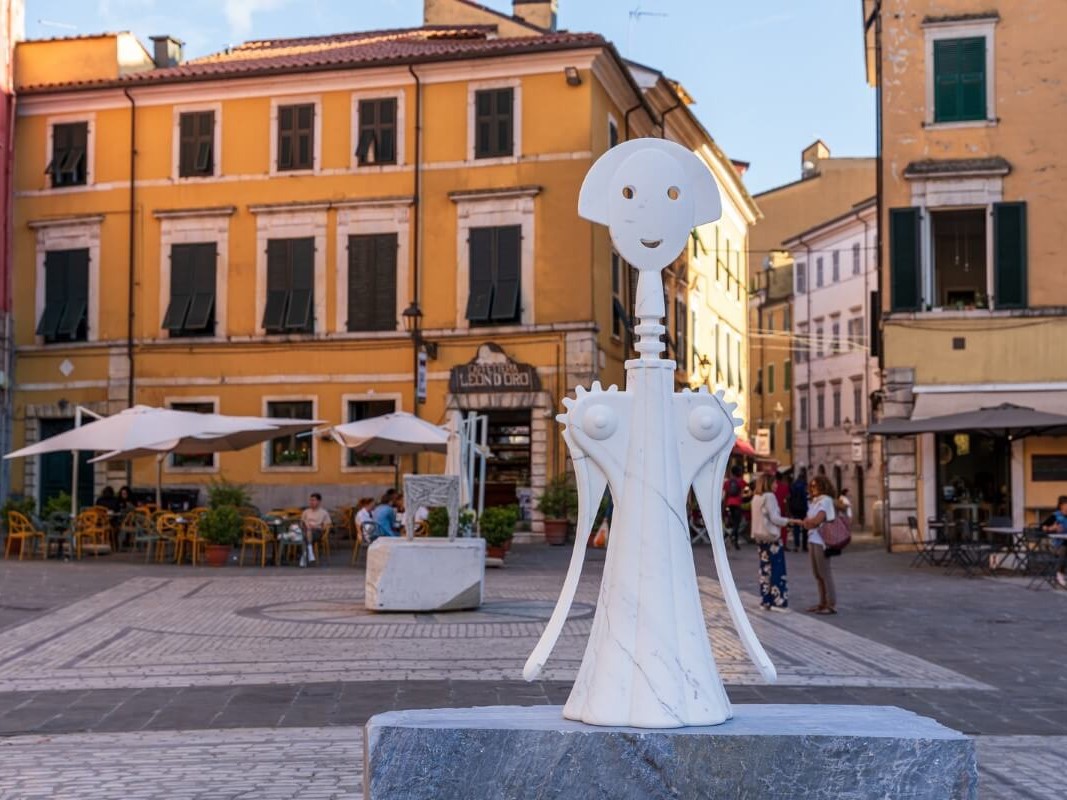
 Alberto Improda
Alberto Improda
Italian design: White Carrara. The City of Marble and Design for Tomorrow
- WTI Magazine #177 Jul 20, 2024
-

 Alberto Improda
Alberto Improda
City of marble par excellence, Carrara has always found in the precious rock of the Apuan Alps its identifying mark, the element that historically distinguishes it in the national and international artistic panorama.
Carrara also represents a reality strongly projected into the Future, characterized by skilled workers and advanced technology, full of energy and skills, which thanks to Design can express all its innovative drive.
White Carrara is the festival that celebrates Italian design and the excellence of the territory, an authentic forge of excellence and creativity: the eighth edition, which began on June 14 and will run until September 29, 2024, is entitled "Design is back."
The event, directed by Domenico Raimondi, offers a widespread exhibition of iconic pieces that tell a story of ingenuity and high craftsmanship, passed down from generation to generation.
White Carrara is produced by the Municipality of Carrara, in collaboration with Internazionale Marmi e Macchine CarraraFiere S.p.A., in co-partnership with the Northwest Tuscany Chamber of Commerce, with the patronage of the Region of Tuscany and the contribution of Fondazione Marmo.
The exhibition is developed around two main nuclei: the return of historical projects made in the city's workshops and new proposals by contemporary designers.
The city for three months becomes a sort of en plein air gallery, an incubator of ideas and projects, a real crossroads for the confrontation between designers, architects and artists, artisans and companies, insiders and enthusiasts.
Among the many noteworthy works is certainly worth mentioning the Anna G. corkscrew, designed by Alessandro Mendini for Alessi.
The sculpture, made of veined marble, is a tribute for the 20th anniversary of the creation of the famous utensil, which has evolved from a mere everyday object to an authentic style icon.
Stefano Giovannoni's Tree Table + Rabbit Chair installation, then, features an attractive and bold combination of phytomorphic and zoomorphic forms.
The original phytomorphic table and rabbit-shaped seats evoke the wonder typical of fairy tale storytelling, contaminating play and ergonomics, narrative and functionality.
A work by Simone Micheli, the Soul pouf represents an expression of peculiar creativity, standing out for its fluid and surprising lines.
The original seat, made of statuary marble, enhances the essence of the raw material with soft, innovative shapes that almost seem to invite visitors to sit down and take a break.
Michele De Lucchi's Plissè collection is celebrated with a marble kettle, the result of a collaboration between Alessi, Franchi Umberto Marmi and Angeloni Marble Studio.
The work, of great lightness and appeal, succeeds in transfiguring the dynamism of the pleated garments typical of the 1950s and 1960s, at the turn of the post-World War II era and the Economic Boom.
The solo exhibitions of Paolo Cavinato and Gabriele Landi, at MudaC - Museo delle arti Carrara, express extremely interesting points of view on modern-day design.
A special mention, within the solo exhibition called Directions, deserves Paolo Cavinato's work entitled Solaris#5, produced site-specific for the museum, which transforms the site into an authentic place of experimentation.
The artist, combining painting, sculpture, photography, architecture, set design and music in his visual language, challenges visitors to investigate the limits and potentialities of their relationship with the world, to measure themselves against the dictates of complexity, to confront doubt, wonder and disquiet.
The museum's project room hosts Gabriele Landi's installation titled "To the Mountains," also unseen and created site-specifically for MudeC.
The work, which is a tribute to Carrara and inspired by "Testamento del capitano," a dramatic song of the Alpini, is presented as an epidermal cartographic map, developed in three dimensions with vibrant colors, evoking the glow of marble under the sun.
White Carrara also offers the Off Circuit, thanks to the participation of local artists, workshops and art galleries, with the historic center coming alive with exhibitions and side events.
The program also includes special events designed specifically for the public, such as guided tours to art workshops and in stone companies, in collaboration with Carrara Studi Aperti, excursions to the quarries, activities for children, musical appointments and food and wine initiatives, with the support of associations and companies.
Particularly noteworthy was the initiative of the Carrara Academy of Fine Arts, which involved students in recovering the memory of design in Carrara, characterized in the recent past by the imprint of great personalities such as Santini, Munari, Coppola and Mangiarotti.
Mario Andrea Rigoni wrote in the early 1990s: "The spirit and strength of a civilization are anything but indifferent to the material to which they rely: the ancient Greek world could imprint itself only in bronze, ivory, gold and marble; ours in plastic, celluloid and paper" (Variazioni sull’impossibile, 1993).
Today, in the Society of Complexity, we are daily grappling with transformations as rapid and profound as ever, with a general and disorienting reshuffling of concepts and intentions.
Design represents a valuable tool to act as a bridge between the Past and the Future, between Tradition and Innovation.
White Carrara, in this context, stands as an extremely important moment, a valuable point of intersection between skills, ideas and generations.